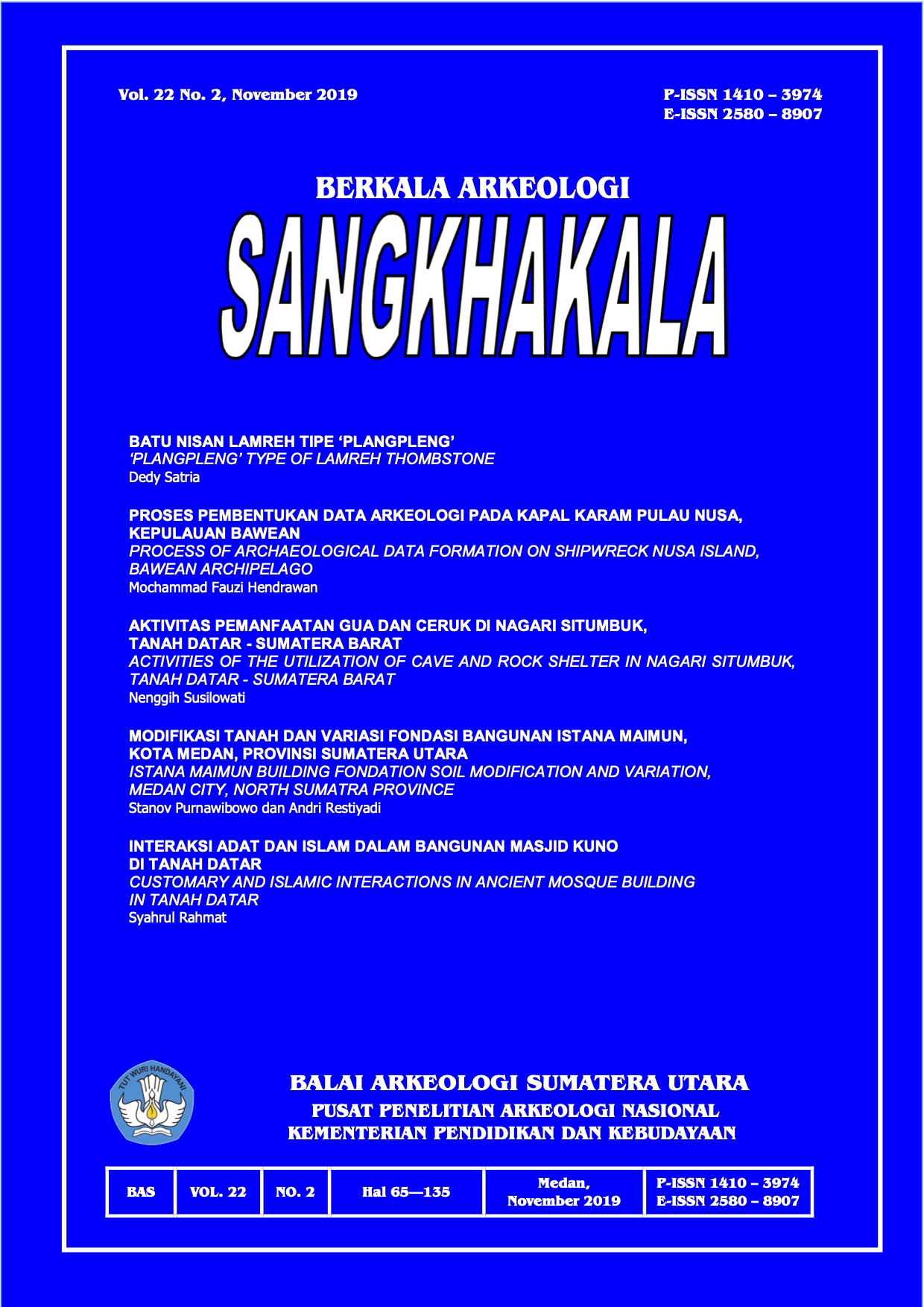PROSES PEMBENTUKAN DATA ARKEOLOGI PADA KAPAL KARAM PULAU NUSA, KEPULAUAN BAWEAN
Main Article Content
Abstract
Indonesian archipelago holds considerably amount of archaeological data includes shipwreck that vary from various periods and types. In Bawean Island, a shipwreck with steamer component indicated from the 19th century named Pulau Nusa was found. In 2016, Pulau Nusa shipwreck was found by Balai Arkeologi Yogyakarta in a fragmentary shape with scattered components. Numbers of scattered components has concreted with coral and the bottom part has gone through sedimentation thus buried in sea floor. This research focused on the underlying process behind the current condition of Pulau Nusa shipwreck. Conducted as an explorative research with inductive reasoning, this research used two main method of analysis, i.e environmental and contextual analysis. These two method of analysis are used to answer the data formation process which divided into two steps, behavioral process (pre-depositional) and transformation process (depositional and post-depositional) along with cultural and noncultural factors that have impact on those process. From the synthesis of two analyses came the conclusion at first the formation of archaeological data influenced by Noncultural transform, but further because it is located in the shallow sea and the existence of human activity due to the economic value of the environment and shipwreck itself, the cultural transformation factor also contributes to the role.
Downloads
Article Details
References
Green, Jeremy. 2004. Maritime Archaeology A Technical Handbook. Second Edition. London: Elsevier Acdemic Press.
Muckelroy, Keith. 1976. “The Integration of historical and archaeological data concerning an historic wreck site: The “Kennemerland”. Dalam World Archaeology, Vol. 7 No.3. Hal. 280-290.
Putra, Heddy Shri Ahimsa. 2007. “Paradigma, Epistemologi dan Metode Ilmu Sosial-Budaya”. Dalam Makalah Ceramah Perkembangan Teori dan Metode Antropologi. Yogyakarta: Jurusan Antropologi, FIB UGM.
Pratama, Henki Riko. 2012. “Proses Pembentukan Data Arkeologi Bawah Air (Studi Kasus Bangkai Kapal Liberty di Tulamben, Bali)”. Skripsi. Yogyakarta: Fakultas Ilmu Budaya UGM.
Priswanto, Hery, 2015. “Bentuk dan Karakter Tinggalan Arkeologi Maritim di Pulau Bawean: Identifikasi Potensi (Tahap I)”. Laporan Penelitian. Yogyakarta: Balai Arkeologi Yogyakarta.
Priswanto, Hery, 2016. “Bentuk Dan Karakter Tinggalan Arkeologi Maritim di Pulau Bawean: Identifikasi Potensi (Tahap II)”. Laporan Penelitian. Yogyakarta: Balai Arkeologi Yogyakarta.
Schiffer, Michael B. 1987. Formation Processes of the Archaeological Record. Albuquerque: University of New Mexico Press.
Sennet, Richard dan Henry J. Oram. 1899. The Marine Steam Engine: A treatise for Engineering Students, Young Engineers and Officers of The Royal Navy and Mercantile Marine. London, Newyork and Bombay: Longmans, Green and Co.
Tanudirjo, Daud Aris. 1998. Ragam Metode Penelitian Arkeologi dalam Skripsi Mahasiswa Arkeologi Universitas Gadjah Mada. Yogyakarta: Laporan Penelitian Fakultas Sastra UGM.
Taufiq, Muhammad. 2017. “Tinggalan Kapal Uap Di Perairan Pulau Bawean: Bentuk, Fungsi dan Peranannya dalam Aktivititas Pelayaran di Masa Lalu. Skripsi. Yogyakarta: Fakultas Ilmu Budaya UGM.
Yuwono, Edy J.S. 1999. “Situs Gunungbang dalam Perspektif Transformasi”, makalah pada Seminar Sehari Penelitian Terpadu Kawasan Arkeologis (PTKA) Gunung Kidul Tahap I: Gunungbang, UGM, 12 Mei 1999. Yogyakarta: Universitas Gadjah Mada.
____________. 2003. “Aspek-Aspek Teknis Ekskavasi dalam Kerangka Pemahaman Transformasi Data”, makalah pada Bimbingan Pelatihan Metodologi Penelitian Arkeologi, Puslitarkenas, Yogyakarta.
Arsip, sumber resmi tercetak, sumber resmi digital dan sumber internet
“Ship Fact Sheet SS BENGAL (1853)”, www.poheritage.com Diakses pada Februari 2018.
www.trove.nla.gov.au Diakses pada Februari 2018.
www.wrecksite.eu Diakses pada Februari 2018.


